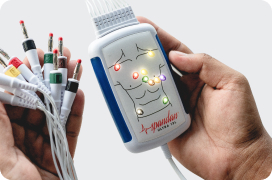
Related Article
Author:- Mr. Ritesh Sharma
The human heart is a complex organ that plays a vital role in maintaining overall health. One of the crucial components of the heart’s anatomy is the circumflex artery, a significant branch of the left coronary artery. In this blog, we will delve into the details of the circumflex artery, its anatomical significance, its functions, and its relevance in various cardiovascular conditions.
What is the Circumflex Artery?
The circumflex artery is a major artery that wraps around the heart’s left atrium, providing oxygen-rich blood to various parts of the heart muscle. It arises from the left coronary artery, which branches off the aorta. The circumflex artery travels along the left atrioventricular groove and supplies blood to the lateral and posterior walls of the left ventricle and parts of the left atrium. Understanding the artery’s role in the cardiovascular system is essential for comprehending heart health and diseases.
Anatomy of the Circumflex Artery
The circumflex artery has a unique anatomical structure that varies from person to person. After branching from the left coronary artery, it extends laterally around the heart. It can be divided into several segments, including the left marginal artery and the posterior left ventricular artery. The left marginal artery supplies blood to the left ventricle’s lateral wall, while the posterior left ventricular artery serves the posterior aspect of the left ventricle.
The circumflex artery’s branching pattern is vital for providing adequate blood supply to the heart muscle. In some individuals, it may supply the sinoatrial (SA) node and atrioventricular (AV) node, which are essential for regulating the heart’s electrical activity. An understanding of this artery’s anatomy helps medical professionals diagnose and treat various cardiac conditions effectively.
Functions of the Circumflex Artery
The primary function of the circumflex artery is to supply oxygenated blood to specific regions of the heart muscle. This blood supply is crucial for maintaining the heart’s metabolic needs. The heart muscle requires a constant supply of oxygen to function effectively, and the this artery plays a significant role in meeting this demand.
When the circumflex artery is healthy, it provides adequate blood flow to the left atrium and left ventricle, ensuring that these chambers can pump blood efficiently. However, any disruption in blood flow through the circumflex artery can lead to various cardiovascular issues, including ischemia and heart attacks. Therefore, understanding the artery’s function is crucial for recognizing the signs and symptoms of heart disease.
Clinical Significance of the Circumflex Artery
The circumflex artery is often involved in various cardiovascular conditions, making it essential to understand its clinical significance. Atherosclerosis, a condition characterized by the buildup of plaque in the arteries, can affect the artery, leading to reduced blood flow to the heart muscle. This condition can result in angina (chest pain) and, in severe cases, myocardial infarction (heart attack).
In addition, the circumflex artery’s involvement in coronary artery disease can vary depending on its anatomy. Some individuals may have a dominant artery, where it supplies more areas of the heart, while others may have a dominant right coronary artery. Understanding these variations is essential for planning interventions such as angioplasty or coronary artery bypass grafting (CABG).
Moreover, the circumflex artery’s proximity to the heart’s electrical conduction system means that any issues affecting its blood supply can impact heart rhythm. Patients with compromised blood flow in the circumflex artery may experience arrhythmias, necessitating careful monitoring and management.
Diagnosing Circumflex Artery Issues
Diagnosing issues related to the circumflex artery typically involves several steps. Healthcare professionals may start with a thorough medical history and physical examination. If cardiovascular disease is suspected, several diagnostic tests may be conducted, including:
- Electrocardiogram (ECG): This test measures the heart’s electrical activity and can identify abnormalities that may indicate issues with the this artery.
- Stress Testing: A stress test evaluates how well the heart functions during physical activity. It can reveal any ischemic changes related to the this artery.
- Coronary Angiography: This imaging technique involves injecting a contrast dye into the coronary arteries to visualize blood flow. It helps identify blockages or narrowing in the circumflex artery.
- Computed Tomography (CT) Angiography: This non-invasive imaging test provides detailed images of the coronary arteries, including the circumflex artery, to assess its condition.
Early diagnosis of this artery issues is vital for preventing severe complications. If blockages or narrowing are detected, healthcare providers may recommend lifestyle changes, medication, or surgical interventions to restore blood flow.
Treatment and Management
The treatment of this artery-related issues often involves a multi-faceted approach. Lifestyle modifications play a crucial role in managing cardiovascular health. Patients are encouraged to adopt a heart-healthy diet, engage in regular physical activity, and avoid smoking. These changes can help improve overall cardiovascular health and reduce the risk of complications.
Medications may also be prescribed to manage conditions such as high blood pressure, high cholesterol, and diabetes, which can contribute to atherosclerosis and circumflex artery issues. In cases of severe blockages, interventional procedures like angioplasty or stenting may be necessary to restore blood flow. Coronary artery bypass grafting (CABG) may also be considered for patients with significant blockages in the this artery.
The circumflex artery is a vital component of the cardiovascular system, supplying blood to essential areas of the heart. Understanding its anatomy, function, and clinical significance is crucial for maintaining heart health and preventing cardiovascular diseases. With early diagnosis and appropriate management, individuals can mitigate the risks associated with this artery issues and promote a healthier heart. Regular check-ups and a proactive approach to heart health can make a significant difference in preventing complications related to the circumflex artery.




